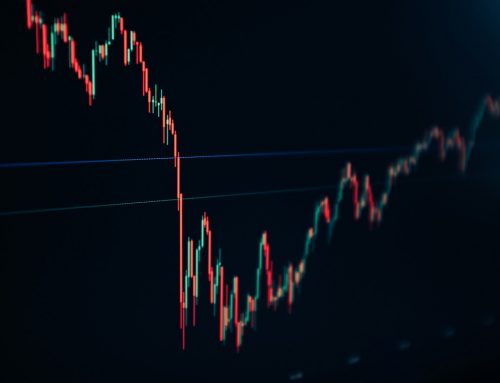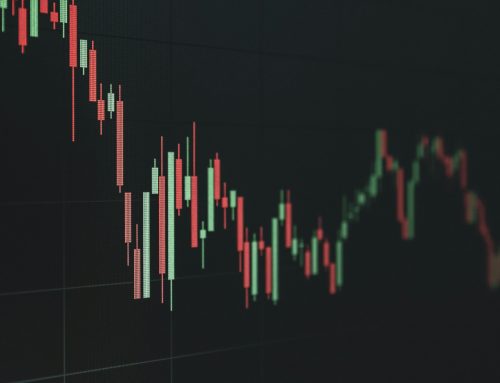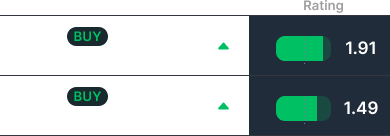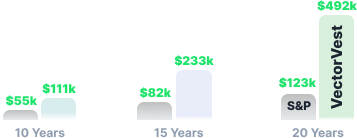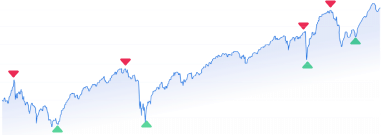Dividend stocks offer a two-pronged approach to investing. Regular dividend payouts provide supplemental income, while stock growth can lead to long-term capital gains.
Not all dividend stocks are equal, though. You’re not willing to settle for a modest 1% yield. You want to find the best high-dividend stocks, and we’re here to help. We’ll share the top 10 high-yield dividend stocks below along with tips on how to invest in high-dividend stocks in the first place.
The best part? You can effortlessly uncover winning opportunities on autopilot through the VectorVest stock analysis software. Not only does this stock trading system offer a pre-curated list of the top dividend stocks on any given day, but it also helps you manage your portfolio with precision and ease, showing when to buy, and sell stocks.
Get started building a stock portfolio with high-dividend yield stocks today!
What is Considered a “High-Dividend” Stock?
Before we get into how to buy high-yield dividend stocks, we need to first define what a “high dividend” is. This is subjective to a certain extent, but we’ll keep things simple and characterize it simply as above average.
Understanding Dividend Yields
Let’s take a step back and explain what a dividend yield is in the first place. This is calculated by dividing the annual dividends paid per share by the price per share.
For instance, if a company pays an annual dividend of $4 per share and the current stock price is $100, the dividend yield would be 4%. This is not bad at all considering the average yield of the S&P 500 might hover around 1.5% to 2%.
All that being said, what is considered a high-yield dividend will also vary between sectors. Utilities and real estate investment trusts (REITs) are traditionally known for higher dividend payouts due to their stable cash flows and regulatory environments.
On the other hand, sectors like technology or consumer discretionary prioritize reinvestment in growth over dividends. This is the main difference between dividend vs growth stocks.
Factors Influencing Dividend Yield
With so much variety between yields, it’s worth discussing the factors that influence how much a company redistributes to its investors. There are 3 driving forces here:
- Company Performance: A high yield can sometimes indicate a company’s mature status, suggesting it has fewer opportunities for explosive growth and thus returns more cash to shareholders. Conversely, it could signal a company in distress, where the dividend yield is high because the stock price has fallen significantly, not necessarily because dividends have increased.
- Strategic Priorities: Companies that prioritize returning income to shareholders might adopt a policy of maintaining high dividends. This approach can attract a specific type of investor, one who prefers steady income over potential capital gains.
- Market Perceptions: A high-dividend yield can sometimes reflect the market’s perception of the company’s future prospects. A stable and rising dividend might be seen as a sign of confidence from management about future earnings, which drives stock prices up. On the other hand, a high yield with a declining stock price might raise concerns about the company’s long-term viability.
Why Invest in High-Yield Dividend Stocks?
Now, why invest in high-yield dividend stocks when you could allocate that capital toward the best aggressive growth stocks that deliver massive returns? Are dividend stocks worth it? Here are some of the benefits of these types of stocks:
- Consistent Income Stream: Provides a steady flow of income, beneficial for those trying to live off dividends in retirement or those needing regular income to meet financial obligations.
- Enhanced Portfolio Yield: Increases the overall yield of an investment portfolio, particularly valuable in low-interest-rate environments where other fixed-income assets might underperform.
- Potential for Total Returns: Offers a combination of regular dividend income and the opportunity for capital appreciation, sweetening the pot with more total returns.
- Diversification Benefits: Sectors like utilities and consumer staples are less sensitive to economic cycles, thereby adding stability to your portfolio during market downturns.
- Tax Efficiency: Dividend income may benefit from more favorable tax treatment compared to other types of income, protecting investment returns.
- Inflation Protection: Well-established companies that pay dividends can often increase their payouts over time, making these the best hedge against inflation in some cases.
It’s clear that the best blue chip dividend stocks can be an integral part of your portfolio. The only question is how to buy high-yield dividend stocks and consistently find new opportunities. We’ll walk you through it below.
How to Buy High Yield Dividend Stocks: Step-by-Step Guide
We’ll share the best high-dividend stocks in just a few moments. But you know what they say – give a man a fish, he’ll eat for a day. Teach a man how to fish and he’ll never go hungry again!
That’s why we’re going to first show you how to buy high-yield dividend stocks so that you can replicate the strategy successfully time and time again as market conditions shift and companies come and go. Here’s how to get started with blue chip investing in high-yield dividend stocks…
Identifying High-Dividend Stocks
First things first, you’re going to want to compile a list of high-dividend stocks. You can use free stock analysis websites for this type of information, or you can invest in the best stock research sites for more detailed insights that go above and beyond.
You could even take things a step further and set up stock screeners that pull in opportunities on a daily basis based on your set criteria for dividend yield. You may want to assess other stock indicators like EPS as well.
Assess the volatility of the company’s earnings over time. Companies with stable and predictable earnings are more likely to sustain and grow dividends.
Like we mentioned earlier, high-dividend yield stocks are great – but stability matters too. So, be sure to take a look at the company’s history and see if you can spot a trend in how the dividend has performed over time. Is it steadily rising, or has it begun shrinking?
The goal is to find stable opportunities you can eat off of for the long run. It’s also worth taking the time to learn how often the stock pays dividends so you know what you can expect from an income standpoint. Another great indicator of a quality stock is a solid debt-to-equity ratio. Excess debt means that future dividends could be at risk of getting cut or even suspended, as companies will be forced to meet debt obligations over returning profits to shareholders.
Adequate free cash flow (FCF) is another sign that a company will have a surplus profit left over on a quarterly basis to reward loyal shareholders without relying on external funding sources.
You can take the time to learn how to analyze stocks in our blog, including how to do fundamental analysis of stocks or how to combine fundamental and technical analysis for the best of both worlds.
Timing Purchases
Figuring out how to pick a stock is actually the easy part. Determining when to buy stocks is the real challenge. Timing is everything in the stock market, and this is especially true when it comes to high-yield dividend stocks.
Buying before the ex-dividend date ensures you receive the upcoming dividend. However, be aware that stocks can often drop in price by approximately the amount of the dividend after this date.
You should also consider market conditions and economic indicators when timing your purchases. Buying during market dips might allow you to secure a better yield on cost. We have tips on how to buy the dip in our blog along with when to sell stocks so you don’t get stuck holding falling stocks.
Building a Diversified Portfolio
We know you came here to find the best high-dividend stocks, but you should make sure your portfolio features a mix of lower-yielding stocks as well. These faster growing stocks will provide both capital appreciation as well as dividend income.
Diversification extends far beyond yield as well. You should include companies from various geographical regions, different sectors, and more to provide exposure to different growth potentials
Reinvestment Strategies
Part of the appeal of high-dividend stocks is the compounding returns you can achieve by consistently reinvesting your dividends. Utilizing DRIPs allows for the automatic purchase of additional shares at no or low cost, facilitating the compounding effect over time.
You could also be more strategic and reinvest based on current stock valuations and future outlook. You may take dividends from one stock to enter a position in another stock.
Or, you may want to take out some of those dividends especially if you’re in retirement or need the cash for financial obligations in the here and now. You can be selective about taking profits where necessary.
Using VectorVest to Save Time and Stress While Winning More Trades
While understanding how to analyze a stock and make informed decisions through traditional approaches is still worthwhile, you don’t have to work harder than necessary in this day and age.
You can leverage technology to save time and stress all while eliminating human error, guesswork, and emotion from your stock investment strategy.
Whether you’re looking for the best stock apps for iPhone or the best stock apps Android, you can count on VectorVest to deliver actionable insights that help you uncover the best high dividend stocks at any given time.
Our stock advisory streamlines your analysis by consolidating complex technical data into clear, actionable insights. You’re given all the insights you need in 3 simple ratings: relative value (RV), relative safety (RS), and relative timing (RT).
Each sits on a scale of 0.00-2.00 with 1.00 being the average, allowing you to quickly and easily make your decisions. Just pick safe, undervalued stocks rising in price and win more trades with less work!
Part of what makes VectorVest the best stock picker is that you can pull up top stocks on any given day and filter based on a number of categories – in this case, you’d want to pull up our “Top Dividend Stocks”. You can then apply your own criteria and find the best high-yield dividend stocks with the press of a button.
Better yet, you never have to stress about managing your positions again. VectorVest offers a clear buy, sell, or hold recommendation for any given stock at any given time so you can continue to evolve your portfolio.
The system has outperformed the S&P 500 index by 10x over the past two decades and counting, and it’s just a click away ready to help you simplify your strategy. Get a free stock analysis today and see how it works yourself!
Top 10 Best High Dividend Stocks in 2025
Now that you know how to buy high-yield dividend stocks, let’s get into some of the best high-dividend stocks in 2025. These were chosen not just for their high yields but also for their consistency and stability as companies:
International Seaways Inc (INSW) – 11.95%
International Seaways is one of the largest tanker companies globally, specializing in the transportation of crude oil and petroleum products.
The company benefits from cyclical recovery in tanker rates and global trade dynamics. High dividends are supported by strong cash flows in the shipping industry during market upturns.
British American Tobacco p.l.c. (BTI) – 10.06%
As a leading global tobacco company, BTI offers a wide range of cigarettes and next-generation products, including vapor and heated tobacco products.
Despite regulatory pressures, BTI maintains strong cash flows due to high brand loyalty and pricing power in the tobacco industry. It’s a giant not just in the UK but abroad as well.
CVR Energy Inc (CVI) – 8.13%
CVR Energy is an independent petroleum refiner and marketer of high-value transportation fuels. The company’s dividend yield is a result of recent improvements to refining margins and favorable crude supply dynamics.
That being said, this is a company you’ll want to invest in with caution given the constant fluctuation in oil prices and ongoing regulatory changes.
Leggett & Platt, Incorporated (LEG) – 10.09%
Leggett & Platt designs and manufactures various engineered components and products found in homes, offices, and automobiles.
Given its diversified product base and innovation in comfort technology, it brings in steady revenue to support its high dividend payouts.
SITE Centers Corp (SITC) – 11.06%
SITE Centers is a REIT that owns and manages open-air shopping centers. As retail rebounds, the company is poised to benefit from high occupancy rates and steady lease incomes, which support its dividends. Real estate market trends are key to its ongoing performance, though, so keep up on these.
Altria Group Inc. (MO) – 9.35%
Altria has a strong portfolio of tobacco brands and is expanding into non-combustible products as well, showing it’s here for the long haul.
While there has been concern about declining cigarette sales, the company’s focus on innovative tobacco products aims to offset these losses. It’s positioned to maintain its substantial dividend.
Barings BDC, Inc. (BBDC) – 11.15%
Barings BDC is a business development company that primarily invests in middle-market companies. Its dividends are driven by high-yield debt investments. The key to sustaining these yields lies in managing credit risk effectively amidst economic shifts.
Kennedy-Wilson Holdings, Inc. (KW) – 11.27%
This global real estate investment company focuses on multifamily and office properties, primarily in the Western US and Europe.
Kennedy-Wilson’s strategy of value-add and redevelopment opportunities, coupled with strong property fundamentals, have it set up to offer substantial dividend yields for years to come.
REV Group Inc (REVG) – 7.77%
REV Group manufactures specialty vehicles, including buses, ambulances, and fire trucks. These essential services mean that the company is positioned to remain resilient against economic downturns, supporting its dividend strategy.
Delek Logistics Partners, LP (DKL) – 10.61%
Delek Logistics operates midstream energy infrastructure assets primarily in the United States. With steady demand for its services and strategic asset placements, the company is able to offer a high dividend yield. That being said, exposure to commodity price volatility is a risk factor.
Final Thoughts on How to Buy High-Yield Dividend Stocks
That does it for our guide on how to invest in high-dividend stocks.
Remember, selecting the right investments goes far beyond chasing the highest yields. You need to find high-yield dividend stocks that are sustainable, too. This involves an analysis of the company’s financial health and the sector it operates in.
You can continue learning about investing after retirement, high volatility stocks, current undervalued stocks, the best stocks to buy for beginners, fundamental vs technical analysis, the best investment apps for beginners, buying and selling stocks the same day, and more in our blog.
But at this point, why not start your search for the best high-dividend stocks by using the best stock analysis app? Clear, actionable insights that help you win more trades with less work are just a few clicks away. Trade smarter with VectorVest today!
What you should do next…
- Get our latest blogs delivered right to your inbox, subscribe to our newsletter.
- The market moves fast! Get our most current evaluation of this stock with our FREE stock analysis tool.
- Looking for stock picks? Not sure if now is the right time to buy/sell? For a limited time, enjoy the full benefits of a 30-day subscription to VectorVest for only [offer_txt] (usually up to [saving_txt]/month) . Get access to our full list of screeners showcasing our top stock picks that tell you exactly what to buy, when to buy, and when to sell.



